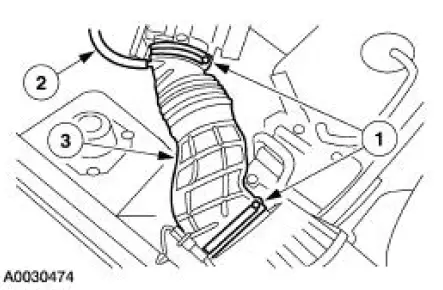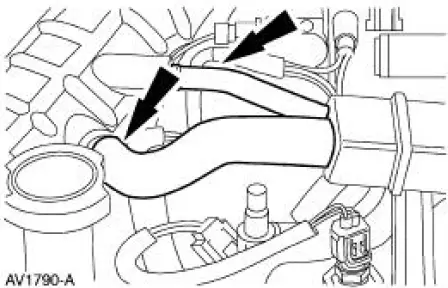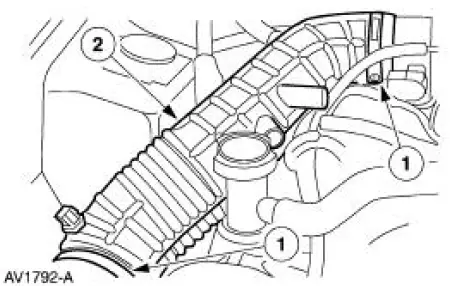Ford Mustang (1999-2004) Service Manual: Air Cleaner Outlet Pipe - 3.8L
Removal and Installation
1. Remove the air cleaner outlet tube.
1. Loosen the clamps.
2. Disconnect the hose.
3. Remove the tube.

2. To install, reverse the removal procedure.
Air Cleaner Outlet Pipe -4.6L (2V)
Removal and Installation
1. Disconnect the hoses.

2. Remove the air cleaner outlet tube.
1. Loosen the clamps.
2. Remove the tube.

3. To install, reverse the removal procedure.
 Intake Air Distribution and Filtering - Supercharger,
Charge Air Cooler
Intake Air Distribution and Filtering - Supercharger,
Charge Air Cooler
The supercharger (SC) is a positive displacement pump. Its purpose is to
supply an excess volume of
intake air to the engine by increasing air pressure and density in the
intake manifold. The sup ...
 Air Cleaner Outlet Pipe - 4.6L (4V)
Air Cleaner Outlet Pipe - 4.6L (4V)
Removal and Installation
Cobra
1. Disconnect the intake air temperature (IAT) sensor.
All vehicles
2. Disconnect the vacuum hose.
3. Disconnect the breather hose.
NOTE: Cobra shown, Mach I sim ...
Other materials:
Weld Nut Repair - Stripped Weld Nut, Restraints
Control
Module (RCM)
WARNING: To avoid accidental deployment and possible personal
injury, the backup
power supply must be depleted before repairing or replacing any front or
side air bag
supplemental restraint system (SRS) components and before servicing,
replacing, ...
Camshaft Journal - Clearance, Plastigage Method
Special Tool(s)
Plastigage
303-D031 (D81L-6002-B) or
equivalent
NOTE: The camshaft journals must meet specifications before checking
camshaft journal clearance.
1. Remove the camshaft bearing cap and lay Plastigage across the surface. Refer ...
Fuel Charging Wiring Harness
Removal and Installation
WARNING: Do not smoke or carry lighted tobacco or open flame of any
type when
working on or near any fuel related components. Highly flammable mixtures are
always present
and may ignite. Failure to follow these instructions may resul ...
